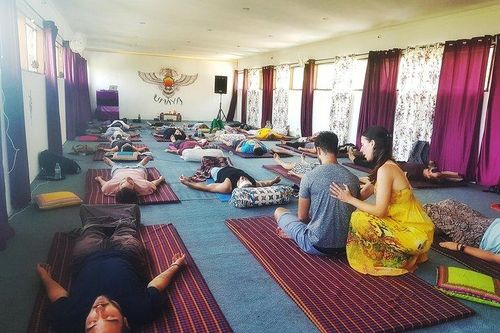Can you recollect breathing rapidly when you saw something you’re afraid of? Or, do you remember breathing calmly to the sound of the ocean waves and being cradled to a gentle sleep?
Your breath responds to your physical, mental, and emotional state. So, naturally, conscious breathing becomes an important concept when it comes to taking care of ourselves and pulling ourselves out of the cycle of stress. Simply stated, Breathwork is a fairly new term that simply refers to the different techniques of consciously connected breathing to regulate our well-being. Therefore, in times of distress, knowing certain breathing techniques can be your lifesaver!
Even though the term is slowly making its way to our dictionaries, Breathwork as a concept is rooted in the ancient practice of Yoga. Briefly explained, Breathwork revolves around the concept of nourishment and elimination of toxins.
Imagine your mind to be a beautiful garden. Your inhalations are the sunshine and water the garden needs to grow. Your exhalations represent pulling out the weeds, and getting rid of them for good. With this metaphor, the benefits of Breathwork can be easily understood.
ORIGIN OF THE PRACTICE AND AS WE KNOW IT NOW
While most individuals can trace the popularity of the Breathwork to the 1960s and 1970s, the practice has its root in even earlier times. The concept is rooted in Yoga, Buddhism, and Tai Chi. Even though Breathwork stems from a variety of Eastern practices, it was pioneered in the West.
Since the 1960s, Breathwork has not grown but evolved. Individuals can go on to pursue certified courses to train in the art and science of Breathwork. Western psychotherapy also involves certain forms of Breathwork therapy as a method of healing.
Today, Breathwork is also combined with elements of music, dance, and certain fragrances.
TYPES OF BREATHWORK
1. Holotropic Breathwork
Holotropic Breathwork was founded by Dr Stan Grof and Christina Grof. It is a guided therapeutic technique that focuses on emotional healing and personal growth. This type of breathwork manipulates the level of oxygen and carbon dioxide in the body. While it is mostly done in a group setting, it can also be done individually.
During the session, participants are asked to breathe rapidly for a certain amount of time while they are lying down. This type of breathing accelerates the journey to altered states of consciousness.
This therapeutic technique integrates the use of music. After the session, individuals are asked to create Mandalas to enhance self-awareness and facilitate healing. Benefits of Holotropic Breathwork include aid in healing depression, relieving stress, treating asthma, and migraines. Psychologically, this type of breathwork is known to help treat symptoms of Post-Traumatic Stress Disorder.
If you’re having trouble finding a direction in your life, Holotropic Breathwork is something you can consider!

2. Rebirthing Breathwork
Rebirthing Breathwork aims to deals with repressed emotions. Repression is an ego-defence mechanism, where the mind pushes an emotion or an event into the unconscious mind to protect the individual from anxiety-provoking thoughts. Therefore, resolving our repressed feelings consequently leads to healthier relationships and attachments.
This technique is also called Conscious Energy Breathing (CEB) which involves conscious connected breathing. During Rebirthing Breathwork, the trainer guides the individual into circular breathing which is devoid of any pauses between inhalations and exhalations.
Several qualified instructors simulate the “rebirthing process” by placing the individual in a cosy and protected womb-like environment, built with pillows and blankets.
This technique is popular for enhancing self-esteem, treating alcohol addiction, healing depression and anxiety, relieving chronic pain, and treating symptoms of Attention Deficit Hyperactivity Disorder among other behavioural issues in children. It is also known to improve respiratory health.

3. Clarity Breathwork
This technique was developed by Ashanna Solaris and Dana DeLong who is better known as Dharma Devi. The technique aims to remove blockages in the path of energies, correct unhealthy patterns and conditioning, and deal with negative thoughts. This breathwork is considered to be closely related to the Rebirthing Breathwork.
Clarity Breathwork makes space for forgiveness and love to widen the horizon of the consciousness. To target certain energies, trainers arrange a discussion with each participant as a way of setting intentions for the session.

4. Shamanic Breathwork
Shamanic Breathwork builds on the notion of how each one of us is our Shamans or healers. It aims to reconnect individuals with their healers within and the subconscious mind. It is known to heal untended wounds and break unhealthy behaviour patterns.
The practice is renowned for its subjectivity. Each individual has a unique experience while practising Shamanic Breathwork that eventually leaves them with a feeling of wholeness. People report having gained profound insight into their lives and their experiences while engaging in this breathing technique. Therefore, this breathwork and trauma release go hand-in-hand.
Like Clarity Breathwork, Shamanic Breathwork also involves setting an intention at the beginning of the session before the individual steps into a sacred space. The experience lasts between 120-150 minutes depending on the individual.
This Breathwork benefit individuals by breaking destructive thoughts and behaviour cycles, dealing with grief, and feeling connected to their selves. It also helps in treating insomnia, oversleeping, migraines, tension and non-physiological pain. Individual practice this breathwork for anxiety relief.

5. Transformational Breathwork
The practice of Transformational Breathwork was founded in the mid-70s by Dr Judith Kravitz. The breathing technique aims to bring more oxygen to the body, enhance energy levels, and circulation. Transformational Breathwork is considered to be an expansion of Holotropic Breathwork. It incorporates elements of Kundalini Yoga, breath analysis, sound healing, and body mapping.
Renowned benefits of the practice include reducing stress, treating respiratory ailments, headaches, and psychosomatic illnesses.

THE BREATHWORK PROCESS
Every breathwork technique involves deep and focused conscious breathing. During our day-to-day breathing, which takes place as an automatic unconscious process, we take pauses between each inhalation and exhalation. However, during conscious breathing, each breath is connected to the other and devoid of any pauses in between. Therefore, the breathwork process is defined as conscious connected breathing.
These breathing techniques are not only associated with treating physical and mental ailments, but also help achieve higher states of consciousness and facilitate healing.
Some breathing exercises that are a part of different breathwork are:
- Box Breathing
- 4-7-8 Breathing
- Pursed Lip Breathing
- Diaphragmatic Breathing

THE BREATHWORK EXPERIENCE
While each individual gains a unique experience through different types of breathwork, the benefits of these conscious breathing techniques aid in self-healing and self-development. In addition to the benefits mentioned above, Breathwork techniques multiply the joy and love in life, heal emotional wounds, and improve physical health.
TIME FOR TRANSFORMATION!
Richie Bostock, a world-renowned practitioner, explained that “By using certain techniques, we are able to turn down the volume of the logical mind and allow for the emotional centres of the brain to play a bigger role in our conscious experience.”
Drawing on Bostock’s statement, you must have understood by now that our breath has a special power over our mind and our overall well-being. Therefore, it is safe to say that Breathwork can be transformative for individuals who practice it consistently under a trained expert.
BREATHWORK IN INDIA
While Pranayama in Yoga is a well-known Breathwork modality, other forms of modalities are also gaining momentum in the country. Because of breathwork’s physiological and psychological implications, guided sessions for different types of Breathwork have popped up across India.
Since the Indian population, because of their association to the practice of Yoga- specifically meditation is already familiar with how chanelling the mind and the inner self can truly be life-changing, incorporating Breathwork is considered another step towards much-needed self-care.
UNLEASH THE MAGIC OF BREATHWORK
“Breathwork is your anchor. Conscious breathing cultivates a resilient aura. When you feel anxious, scared, or uncertain learn to stay with the breath.”
At YogAmoreShala, we offer Shamanic Breathwork as described above. If you are not truly happy, are feeling stuck or insecure, Shamanic BreathWork will provide you with the tools you need to bring about real change, reconnect with your higher selves, and find your true purpose
